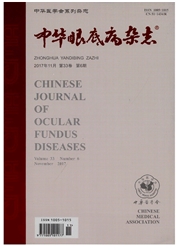

 中文摘要:
中文摘要:
目的观察探讨视网膜变性大鼠视网膜神经节细胞(RGCs)的变化及其触发因素。方法出生后21、60、90d含色素的RoyalCollegeofsurgeons(Rcs)-p’视网膜变性大鼠各6只,RCS-rdy+-p+无视网膜变性大鼠各6只。立体定位下行大鼠上丘和外膝体荧光金逆行标记RGCs,荧光显微镜下观察RGCs细胞形态并计数。作视网膜铺片和切片,采用激光共聚焦显微镜观察RGCs细胞内钙成像情况,分析RGCs细胞内钙浓度的变化。结果荧光显微镜观察发现,出生后90d,无视网膜变性大鼠RGCs分布于整个视网膜,细胞大小均一,细胞胞体和突起清晰可见;视网膜变性大鼠RGCs分布稀疏,细胞大小不一,细胞突起分枝数和范围减小,出现杆状或碎屑细胞。出生后21、60、90d,视网膜变性大鼠RGcs数量分别为(5421.0±72.1)、(4195.0±136.4)、(2906.0±133.2)个/mm2。与无视网膜变性大鼠比较,出生后21d时其RGCs数量间差异无统计学意义(t=-1.301,P〉0.05);出生后60、90d时其RGCs数量显著减少,差异有统计学意义(t=16.172,30.131;P〈O.05)。出生后21d有无视网膜变性大鼠RGCs细胞内钙荧光强度比较,差异无统计学意义(t=-1.545,P〉0.05);出生后60、90d视网膜变性大鼠RGCs细胞内钙荧光强度较无视网膜变性大鼠明显增强,差异有统计学意义(t=-18.058,-15.015;P〈0.01)。结论视网膜变性大鼠RGCs发生变性死亡,细胞形态和数量受到显著影响。RGcs细胞内钙浓度的变化可能是视网膜变性中RGCs继发变性、死亡的触发因素。
 英文摘要:
英文摘要:
Objective To investigate the triggering mec-hanisms of retinal ganglion cells (RGCs) alterations in retinally degenerative rats. Methods Retinal dystrophic Royal College of Surgeons (RCS-p+ ) and control RCS rats (RCS-rdy+-p+ ) were divided into three groups according to postnatal days, including postnatal 21 days (P21d), P60d and P90d, with six rats in each group. Fluorogold was injected into superior eolliculus and lateral geniculate body for retrograde labeling RGCs. Then retinal flat mounts were observed under fluorescence microscope to investigate the morphological and RGC changes in density during retinal degeneration. Living retinal mounts or sections were prepared to investigate the calcium concentration of RGCs using a laser confocal microscope. Results At P90d RGCs of control rats were distributed throughout entire retina and appeared uniform. The soma and processes were apparent and clear. But at P90d RGCs of RCS-p+ rats were distributed sparsely in retina. The soma seemed messy and the number and dendritic fields decreased greatly, and some baculiform or broken cells appeared. RGC density was 5 421.0±72. 1/mm2 at P21d, 4 195.0±136.4/mm2 at P60d and 2 906.0±133.2/mm2 at P90d. At P21d there were no obvious differences in RGCs density between RCS-p+ and control rats (t=-1. 301, P〉 0.05). At P60d and P90d there were significant differences in RGC density (t= 16. 172, 30. 131; P〈 0.01). At P21d there was no significant differences in RGC intracellular calcium fluorescence intensity between RCs-p+ and control rats (t=- 1. 545, P〉0.05). At P60d and P90d the intracellular calcium fluorescence intensity decreased obviously and the differences were significant (t= 18. 058,-15. 015; P〈 0.01). Conclusions RGCs were secondarily impaired following the loss of photoreceptors at late stages of retinal degeneration, and the morphological and cell density of RGCs were affected. The overloading of intracellular calcium concentration may be the triggering factor of d
 同期刊论文项目
同期刊论文项目
 同项目期刊论文
同项目期刊论文
 期刊信息
期刊信息
